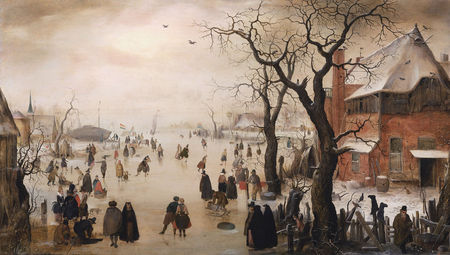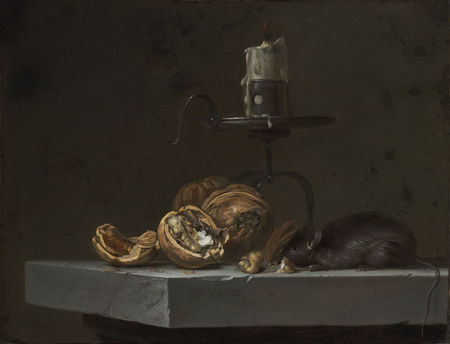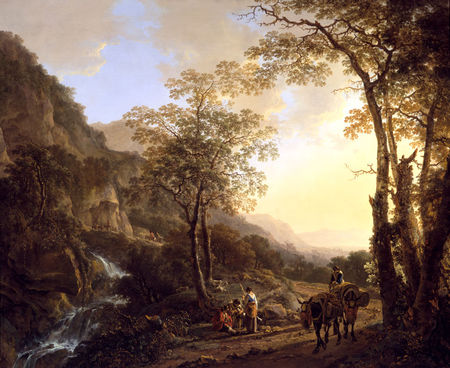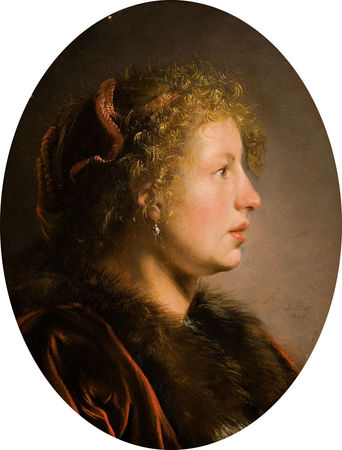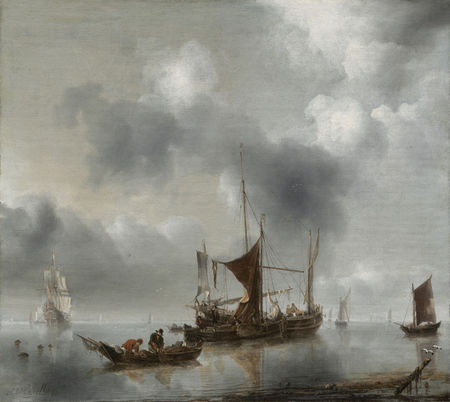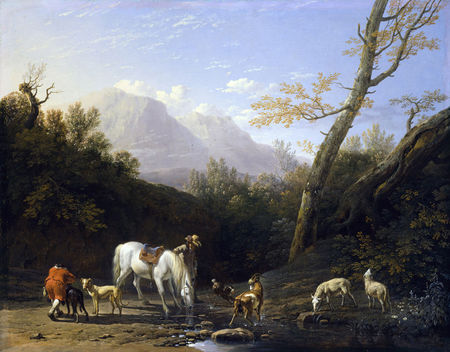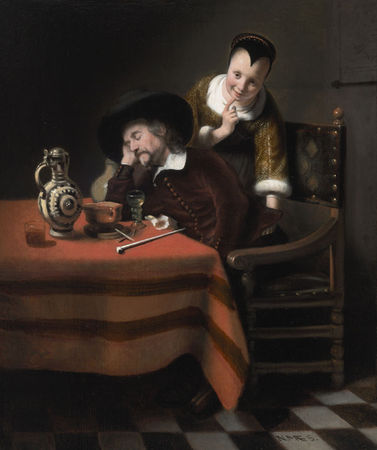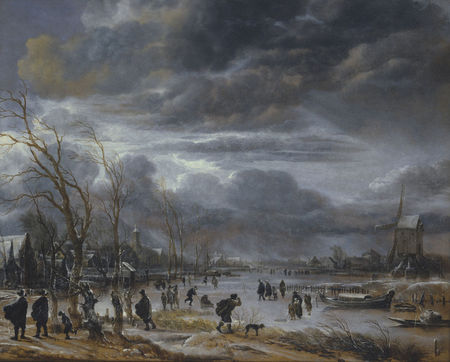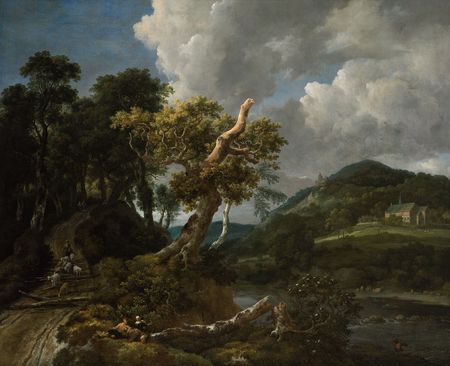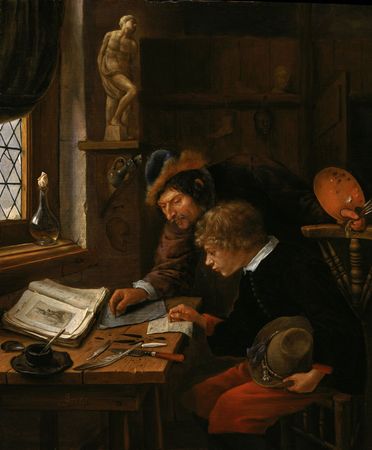The Mauritshuis, The Hague, 4 November 2010 to 30 January 2011 "Made in Holland: Old Masters from a private collection in America"
The Peabody Essex Museum, Salem, Massachusetts, February 26, 2011 to June 19, 2011
Fine Arts Museums of San Francisco, "Dutch and Flemish Masterworks from the Rose-Marie and Eijk van Otterloo Collection"
July 9, 2011 – October 2, 2011
Museum of Fine Arts in Houston, "Dutch and Flemish Masterworks from the Rose-Marie and Eijk van Otterloo Collection," Nov 13, 2011 -
Feb 12, 2012
Related exhibition:
Golden Light, Selections from the Van Otterloo Collection
The Peabody Essex Museum, Salem, Massachusetts August 11, 2012 - May 30, 2014Following the tremendous public and critical acclaim of PEM's 2011 exhibition, Golden: Dutch and Flemish Masterworks from the Rose-Marie and Eijk van Otterloo Collection, the museum is proud to once again exhibit works from the renowned Van Otterloo collection. Featuring 17th century paintings, Golden Light, Selections from the Van Otterloo Collection explores Dutch art and life in the 1600s. This new installation features 15 paintings by Jan Lievens, Emanuel de Witte, Pieter Claesz, Jan Brueghel the Elder and notable others.
Maria Schalcken (ca. 1647/50 - 1684/1709), The Artist at Work in Her Studio, ca. 1680, Oil on panel, The Rose-Marie and Eijk van Otterloo Collection.
History of a Collection
Dutch collectors Eijk and Rose-Marie de Mol van Otterloo, started collecting after their marriage in 1974, initially acquiring antique carriages and English sporting prints. Peter Sutton, current director of the Bruce Museum in Greenwich, Connecticut, suggested that they collect works by seventeenth-century Dutch masters. Simon Levie (advisor from 1995), former director of the Rijksmuseum in Amsterdam, and Frits Duparc, former director of the Mauritshuis (who took over from Levie in 2009), were closely involved in shaping this exceptionally beautiful collection.
Paintings of extraordinarily high quality continue to be added, such as Rembrandt’s Portrait of Aeltje Uylenburg:
Rembrandt (1606-1669), Portrait
of Aeltje Uylenburgh, 1632. Panel (oval), 74 x 56 cm. The Hague, Royal
Picture Gallery Mauritshuis
in 2005, which the couple themselves describe as ‘the jewel in our collection’s crown’, and Gerrit Dou’s Still Life with Sleeping Dog (1650):
Gerrit Dou (1613-1675), A Resting Dog, 1650. Panel, 17 x 22 cm. The Hague, Royal Picture Gallery Mauritshuis
‘love at first sight’. Masterpieces by Aert van der Neer, Esaias van de Velde, Gabriel Metsu, Salomon de Bray and Pieter Claesz were acquired in 2008 and 2009.
All Genres Represented
A pretty, yet insolent young girl, a dog sleeping peacefully, winter landscapes or a summer scene with shepherds and picturesque mountains: the pictures in Made in Holland illustrate the versatility of seventeenth-century Dutch painting. In the exhibition, first-rate paintings will be grouped in ensembles, with an emphasis on still lifes, landscapes, genre paintings and portraits.
Among the still lifes, a number of rare works by painters from Middelburg, including Balthasar van der Ast, Ambrosius Bosschaert and Adrian Coorte, are of particular interest. These will be shown alongside works by famous still-life painters such as Jan Davidsz de Heem and Willem Heda.
The Dutch landscape is well represented with, among others, three works by the leading landscape artist of the Golden Age, Jacob van Ruisdael. The work of Nicolaes Berchem, Jan Both, Karel du Jardin and Adam Pijnacker focuses on the Italian landscape.
Father and son Willem van de Velde the Elder and Willem van de Velde the Younger depict the Dutch Republic as a seafaring nation. Admirers of seascapes like also enjoyed Jan van de Cappelle and Simon de Vlieger’s beautiful paintings.
In the portraits section, masterpieces by Rembrandt and Frans Hals stood out, while everyday life took center stage in the work of painters such as Jan Steen, Nicolaes Maes, Adriaen van Ostade and Frans van Mieris the Elder. An unexpected highlight was the painting Orpheus Charming the Animals (c. 1640), an early work by Aelbert Cuyp:
Aelbert Cuyp (1620-1691), Orpheus Charming the Animals, c.1640. Canvas, 113 x 167 cm. The Hague, Royal Picture Gallery Mauritshuis
In 2011, the complete collection of paintings, together with a smaller collection of antique furniture and objets d’art, went on display in the Peabody Essex Museum in Salem, Massachusetts. The exhibition then moved to the Fine Arts Museums of San Francisco and finally to the Museum of Fine Arts in Houston.

The 68 exquisite paintings in the Van
Otterloo collection - portraits, still lifes, landscapes, history
paintings, maritime scenes, city profiles and genre scenes - were
created in the 1600s as the Dutch Republic increased in maritime
strength and dominated international trade. Elsewhere in Europe, the
nobility and the Catholic Church were the principal patrons of the arts,
but in the Netherlands, merchants supported artists in unprecedented
numbers. Corrigan notes that "the creative revival and widespread
patronage of the arts in the Netherlands was by no means limited to
paintings. Master craftsmen created works in silver, wood and
mother-of-pearl that were equally prized by their collectors." The
exhibition also features twenty-three examples of furniture and
decorative arts from the Van Otterloo collection. All of these works
graced domestic spaces in the Netherlands as people began to invest
enthusiastically in fine art and welcome it into their homes.
 Eijk
van Otterloo was born in the Netherlands and Rose-Marie in Belgium.
They met and married in the United States, where they developed deep
ties with New England. The couple enjoys living with their collection,
but they are also dedicated to sharing it with others, generously
lending to institutions around the globe. The Van Otterloos have said,
"With Golden, we are delighted to have this opportunity to
share the entire collection with the American public. Within these
works of art lie a world of beauty, meaning and even humor. We hope
that visitors to the exhibition receive as much pleasure, inspiration
and delight from them as we do."
Eijk
van Otterloo was born in the Netherlands and Rose-Marie in Belgium.
They met and married in the United States, where they developed deep
ties with New England. The couple enjoys living with their collection,
but they are also dedicated to sharing it with others, generously
lending to institutions around the globe. The Van Otterloos have said,
"With Golden, we are delighted to have this opportunity to
share the entire collection with the American public. Within these
works of art lie a world of beauty, meaning and even humor. We hope
that visitors to the exhibition receive as much pleasure, inspiration
and delight from them as we do."
Over the last two decades, the Van
Otterloos have assembled a Dutch and Flemish collection reflecting
their cultural heritage and rivaling any of its kind in the world. With
expert guidance from Dr. Simon Levie, former director of the
Rijksmuseum in Amsterdam, and Dr. Frederik J. Duparc, former director of
the Mauritshuis in The Hague, the Van Otterloos established clear
goals and criteria, making the choices - sometimes to acquire,
sometimes to decline or sell- that hone a connoisseur's discerning eye.
Great works of art transcend
categorization, but to provide context for the vast flowering of Dutch
and Flemish art in the Golden Age, the exhibition is organized to
reflect the principal themes that artists explored in this period.
 Lured
by religious freedom and a better economic climate, many artists fled
northward from cities such as Antwerp, Brussels and Bruges to escape
persecution and the war with Spain in the late 1500s and early 1600s.
They introduced sophisticated new painting styles and together with
Dutch artists created a climate of artistic excellence in the Dutch
Republic.
Lured
by religious freedom and a better economic climate, many artists fled
northward from cities such as Antwerp, Brussels and Bruges to escape
persecution and the war with Spain in the late 1500s and early 1600s.
They introduced sophisticated new painting styles and together with
Dutch artists created a climate of artistic excellence in the Dutch
Republic.
Artists emphasized the horizon line and
changing weather conditions of the Dutch countryside, often populating
scenes with engaging details of daily life. From the 1560s to the
1620s, Northern Europe endured an extremely cold period known as the
"Little Ice Age." Inspired by the winter landscapes of Flemish artists
who had fled to Amsterdam,Hendrick Avercamp elevated the subject to a
new genre in works such as his Winter Landscape Near a Village.
Faith and Dutch Pride
 Dutch
cities swelled with the influx of immigrants from the south taking
refuge in religiously tolerant, albeit strongly Protestant, urban
environments. Protestant churches in the Netherlands were largely
devoid of religious imagery. Instead, artists painted images of
biblical figures and contemporary religious structures such as Jan van
der Heyden's View of the Westerkerk, Amsterdam for display in people's homes as expressions of their piety and affluence.
Dutch
cities swelled with the influx of immigrants from the south taking
refuge in religiously tolerant, albeit strongly Protestant, urban
environments. Protestant churches in the Netherlands were largely
devoid of religious imagery. Instead, artists painted images of
biblical figures and contemporary religious structures such as Jan van
der Heyden's View of the Westerkerk, Amsterdam for display in people's homes as expressions of their piety and affluence. Successful
merchants, powerful politicians, influential scholars and other
prominent individuals often commissioned portraits of themselves, their
spouses, and sometimes their children. Rembrandt's portrait of Aeltje
Uylenburgh, the unquestionable jewel of the Van Otterloo collection, is
one of the finest portraits by Rembrandt in private hands. Although the
artist painted it when he was only twenty-six, Rembrandt sensitively
rendered the effects of age and tenderly captured his subject's soft
cheeks, bright eyes, and crisp linen cap.
Successful
merchants, powerful politicians, influential scholars and other
prominent individuals often commissioned portraits of themselves, their
spouses, and sometimes their children. Rembrandt's portrait of Aeltje
Uylenburgh, the unquestionable jewel of the Van Otterloo collection, is
one of the finest portraits by Rembrandt in private hands. Although the
artist painted it when he was only twenty-six, Rembrandt sensitively
rendered the effects of age and tenderly captured his subject's soft
cheeks, bright eyes, and crisp linen cap. The
daily lives of the rich and poor became a new subject for painting
during the Dutch Golden Age. These sometimes humorous genre scenes also
contain allegorical symbolism. The importance of frugality and modesty,
and the fleeting nature of life, were especially popular themes in a
society grappling with how to express its new-found prosperity while
maintaining a pious and humble lives. In this scene by Nicolaes Maes, a
woman deftly picks the pockets of a sleeping man while coyly inviting
the viewer's silence. A beautiful and perhaps cautionary still life of
glasses, jars, pipes and tobacco alludes to the sources for the man's
drowsy vulnerability. Maes studied with Rembrandt and is regarded as
one of his most important pupils.
The
daily lives of the rich and poor became a new subject for painting
during the Dutch Golden Age. These sometimes humorous genre scenes also
contain allegorical symbolism. The importance of frugality and modesty,
and the fleeting nature of life, were especially popular themes in a
society grappling with how to express its new-found prosperity while
maintaining a pious and humble lives. In this scene by Nicolaes Maes, a
woman deftly picks the pockets of a sleeping man while coyly inviting
the viewer's silence. A beautiful and perhaps cautionary still life of
glasses, jars, pipes and tobacco alludes to the sources for the man's
drowsy vulnerability. Maes studied with Rembrandt and is regarded as
one of his most important pupils. Intrigued
by new translations of ancient Greek myths, many Dutch artists
incorporated classical imagery in their work. In this monumental canvas
by Aelbert Cuyp, Orpheus plays the violin for an enchanted menagerie of
animals from Europe and around the globe. Cuyp's ambitious paintings
not only highlight his skills as a landscape and animal painter, but
also the era's lively exchange of artistic, literary and scientific
ideas. Cuyp, who never left Europe and would not have seen many of
these animals firsthand, drew upon prints and
Intrigued
by new translations of ancient Greek myths, many Dutch artists
incorporated classical imagery in their work. In this monumental canvas
by Aelbert Cuyp, Orpheus plays the violin for an enchanted menagerie of
animals from Europe and around the globe. Cuyp's ambitious paintings
not only highlight his skills as a landscape and animal painter, but
also the era's lively exchange of artistic, literary and scientific
ideas. Cuyp, who never left Europe and would not have seen many of
these animals firsthand, drew upon prints and  stuffed
specimens in aristocratic "cabinets of curiosities" to depict them.
Allegorical imagery was not limited to paintings in 17th-century
Dutch households. The owner of this stunning four-door cupboard could
display it and avoid the criticism of ostentation because the cupboard
served as a daily reminder of his religious obligations-a veritable
"sermon in wood."
stuffed
specimens in aristocratic "cabinets of curiosities" to depict them.
Allegorical imagery was not limited to paintings in 17th-century
Dutch households. The owner of this stunning four-door cupboard could
display it and avoid the criticism of ostentation because the cupboard
served as a daily reminder of his religious obligations-a veritable
"sermon in wood." The
Dutch Republic dramatically expanded its influence and financial
prospects through voyages around the globe, becoming the dominant
international maritime power in the 17th-century.
Accordingly, Dutch artists were the first to paint the sea in its own
right - a reflection of the importance of water in the nation's psyche.
Maritime views are often characterized by precise depictions of ships
and atmospheric rendering of the weather. The fertile landscape was
similarly a favorite new subject. Cloud-filled skies billowing over a
narrow stretch of earth or sea emphasize the flat horizons for which the
Netherlands is known.
The
Dutch Republic dramatically expanded its influence and financial
prospects through voyages around the globe, becoming the dominant
international maritime power in the 17th-century.
Accordingly, Dutch artists were the first to paint the sea in its own
right - a reflection of the importance of water in the nation's psyche.
Maritime views are often characterized by precise depictions of ships
and atmospheric rendering of the weather. The fertile landscape was
similarly a favorite new subject. Cloud-filled skies billowing over a
narrow stretch of earth or sea emphasize the flat horizons for which the
Netherlands is known. The
carefully balanced compositions in Dutch still lifes are often visual
odes to prosperity and pleasure with elements of moralistic symbolism.
As the nation emerged as a powerful mercantile force, Dutch artists
filled their canvases with the staples and luxuries of the trades they
dominated - Dutch cheese, French wine, Baltic grain, South American
tobacco, and Asian porcelain and pepper.
The
carefully balanced compositions in Dutch still lifes are often visual
odes to prosperity and pleasure with elements of moralistic symbolism.
As the nation emerged as a powerful mercantile force, Dutch artists
filled their canvases with the staples and luxuries of the trades they
dominated - Dutch cheese, French wine, Baltic grain, South American
tobacco, and Asian porcelain and pepper.
When painting seemingly informal
assemblages, Dutch artists played with balance and depth to enhance the
drama and intimacy of the scene. In Jan Davidsz. de Heem's Glass Vase with Flowers on a Stone Ledge, the
artist used light in innovative ways, spotlighting the intensely
colored flowers against a deep black background. The vase contains
flowers that bloomed at different times of the year, somehow enhancing
their beauty by combining faithful representation with impossibility.
Golden: Dutch and Flemish Masterworks from the Rose-Marie and Eijk van Otterloo Collection. Peabody
Essex Museum in conjunction with the Mauritshuis, The Hague, and in
association with Yale University Press. 2011; 404 pages.
Hendrick Avercamp (1585-1634), Winter Landscape with Skaters, c.1610-1615. Panel, 53 x 95 cm. The Hague, Royal Picture Gallery Mauritshuis
Willem van Aelst (1627-c.1683), Still Life with a Candle, Walnuts and a Mouse, 1647. Copper, 19 x 25 cm. The Hague, Royal Picture Gallery Mauritshuis
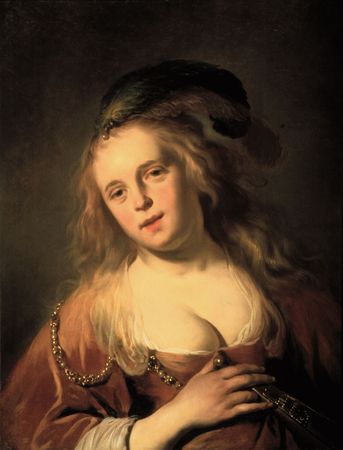
Jacob Backer (1608/9-1651), Young Woman Holding a Fan, c.1644-1645. Panel, 69 x 57 cm. The Hague, Royal Picture Gallery Mauritshuis
Jan Both (c.1615-1652), Italianate Landscape with Travellers, c.1645-1650. Canvas, 138 x 168 cm. The Hague, Royal Picture Gallery Mauritshuis
Salomon de Bray (1597-1664), Bust of a Young Woman in Profile, 1636. Panel (oval), 27 x 21 cm; The Hague, Royal Picture Gallery Mauritshuis
Jan van de Cappelle (1626-1679), Boats in a calm sea, 1651. Canvas, 48 x 53 cm. The Hague, Royal Picture Gallery Mauritshuis
Karel du Jardin (1626-1678), A Horseman at a River, 1660. Canvas, 36 x 46 cm. The Hague, Royal Picture Gallery Mauritshuis
Nicolaes Maes (1634-1693, A Young
Woman Picking the Pocket of a Sleeping Man, c.1655. Panel, 36 x 30 cm.
The Hague, Royal Picture Gallery Mauritshuis
Aert van der Neer (1603/4-1677),
Figures in a Snowstorm, c.1655-1660. Canvas, 61 x 76 cm. The Hague,
Royal Picture Gallery Mauritshuis
Jacob van Ruisdael (1628-1682), Wooded Landscape, c.1655-1660. Canvas, 109 x 142 cm. The Hague, Royal Picture Gallery Mauritshuis
Rachel Ruysch (1664-1750), Still Life with Flowers, 1709. Canvas, 78 x 64 cm. The Hague, Royal Picture Gallery Mauritshuis
Jan Steen (1626-1679), The Drawing Lesson, c.1660-1665.. Panel, 24 x 21 cm. The Hague, Royal Picture Gallery Mauritshuis





